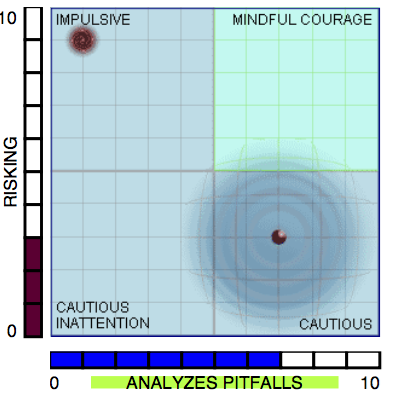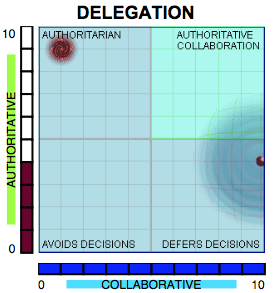 Last week, a passenger with a valid ticket was forcibly removed from a United Airlines plane. Another passenger video recorded him being dragged, bloodied and dazed. You may have seen the video or heard about the incident. Leaving aside the moral and ethical concerns, how much do you think this customer service debacle cost United? According to this article by David Von Drehle in Time online, United’s stock took a beating to the tune of almost $1.5 billion, just from investors bailing out. That doesn’t even take into consideration the lost business and potential lawsuits. Quite a price to pay for a situation caused by a bad decision that could have been prevented.
Last week, a passenger with a valid ticket was forcibly removed from a United Airlines plane. Another passenger video recorded him being dragged, bloodied and dazed. You may have seen the video or heard about the incident. Leaving aside the moral and ethical concerns, how much do you think this customer service debacle cost United? According to this article by David Von Drehle in Time online, United’s stock took a beating to the tune of almost $1.5 billion, just from investors bailing out. That doesn’t even take into consideration the lost business and potential lawsuits. Quite a price to pay for a situation caused by a bad decision that could have been prevented.
I’ve heard several people wonder out loud, “What were they thinking?” I submit that it might have had more to do with how they think and make decisions. So how can we know what kind of decisions the people we hire are prone to making? Fortunately, tools like Harrison Assessments (HA) can give us a good idea. HA utilizes Paradox Theory to assess behavioral traits. Paradox Theory holds that a trait can be either constructive (positive) or destructive (negative), depending on other complementary traits. For example, when frankness is complemented by diplomacy, it takes the constructive form of being forthright and truthful. However, without the complementary trait of diplomacy, frankness becomes bluntness. While frankness and diplomacy appear to be contradictory, they paradoxically co-exist, complementing each other.
While there is no way to be certain without administering an assessment, I suspect that if I had the results of a Harrison Assessment for the decision-maker, they might look like the following.
Opinions
The Opinion Paradox has two primary traits: Certain and Open/Reflective. Certain is the tendency to feel confident in one’s opinions. Open/Reflective is the tendency to reflect on many different viewpoints. The decision-maker probably would have scored high on the Certain trait and low on Open/Reflective. This person would be convinced that their opinion was correct. They would not seek the opinions of others, and would not pay much attention to any different ideas about how to handle the situation. Even if other employees cautioned against the course of action, their opinions would not have had much influence on the decision-maker.
Strategic
The primary traits for the Strategic Paradox are Risking and Analyzes Pitfalls. Risking indicates the tendency to feel comfortable with business ventures that involve uncertainty. Analyzes Pitfalls refers to the tendency to scrutinize potential difficulties related to a plan or strategy. Available information indicates a decision-maker who would score high on the Impulsive side of the Risking trait and low on the Cautious side of Analyzes Pitfalls. Even the most rudimentary risk assessment would have indicated the potential consequences for such a radical solution could be disastrous, not only as a customer service nightmare, but financially as well.
Driving
Enforcing and Warmth/Empathy are the primary traits for the Driving Paradox. Enforcing means the tendency to insist upon necessary rules being followed. Warmth/Empathy is the tendency to express positive feelings and affinity toward others. I think it’s obvious that the decision-maker would have scored low on the Warmth/Empathy spectrum. Even a tiny amount of empathy for the customer would have prevented the incident. If you’ve been following the story, you know that airlines can, in fact, bump customers in certain situations, up to and including removing them from flights. The decision-maker in this case was intent on enforcing the rules and likely would score high on the Harsh side of the Enforcing scale, but was severely lacking in Warmth/Empathy.
Decision Approach
The primary traits for the Decision Approach Paradoxare Analytical and Intuitive. Analytical is the tendency to logically examine facts and situations, while Intuitive is the tendency to use hunches to help make decisions. To make good decisions, you have to be able to logically analyze problems and use intuition. I believe this decision-maker would have scored very low in both Analytical and Intuitive traits. Even a quick analysis would have revealed the potential for a very public customer service failure, and most people with even moderate amounts of Intuitiveness would have had a hunch or “gut feeling” that this was a bad idea.
Bad decisions made by employees can have catastrophic public relations consequences and devastating financial impact on an organization. The total impact of this traumatic event remains to be seen, but I think it’s safe to say that it will cost United plenty—and not all of it money–before it’s over.
Are you worried that you’ve hired someone who could make a million-dollar mistake at your company? Visit my website at www.theperformancedifference.com or email me at laurie@theperformancedifference.com to discuss how you can avoid putting the wrong person in a position who might do irreparable harm by making epically bad decisions.
Companies invest a great deal of their budgets on recruiting, developing, and retaining high-performing employees. The costs of a bad hire or promotion are well-documented, with one SHRM (Society for Human Resource Management) study estimating the cost of replacing a salaried employee to be as much as six to nine months’ salary. In addition, too frequently employees don’t live up to expected performance levels, don’t become fully engaged, and move on to other organizations.
 With all the pressure on businesses to not only meet these challenges, but to do it right the first time, it’s understandable that they would seek help. In response, there has been an upswing in the use of assessments to acquire, develop, and promote the best talent.
With all the pressure on businesses to not only meet these challenges, but to do it right the first time, it’s understandable that they would seek help. In response, there has been an upswing in the use of assessments to acquire, develop, and promote the best talent.
When evaluating an assessment to see if it’s right for your organization, be sure that it measures the critical considerations of eligibility AND suitability for a position. Eligibility relates to the individual’s previous experience, educational qualifications and various skills or abilities necessary to perform in the job. Suitability relates to behavioral issues such as preferences, tendencies, attitudes and behavioral competencies necessary to perform well in the job.
Assessing Eligibility
Avoid the pitfall of setting only minimum eligibility requirements. That only helps eliminate people who don’t meet the minimum standards. It does nothing to determine which applicants are best qualified.
Create a list of eligibility factors. Five to ten items usually capture the most-needed requirements. Consider things like:
- What education is required?
- What previous experience is required?
- What skills are required that might not be covered by education or experience?
Once you have the eligibility factors, assign weight to each factor based on how important it is in relation to the other factors. There is software available to make the process of weighting and scoring eligibility factors easy. You can even automate your recruitment process by using online questionnaires that can score the result and provide you with an immediate eligibility score.
Assessing Suitability
Suitability or behavioral factors are more difficult to assess than eligibility factors because no objective and verifiable information is easily available. Subtle balances between factors have significant implications for behavior. To make it even more challenging, applicants tend to withhold or distort information that might keep them from getting a job.
Since suitability/behavioral factors are about 50% of why people succeed or fail in a role, effectively measuring the factors is an essential part of an assessment. Look for an assessment that:
- Measures a large number of suitability factors
- Provides effective lie prevention and detection
- Produces results related to specific jobs
- Offers easy-to-understand, job-specific scoring that guides interpretation
Why Job-Specific?
Asking questions that appear to be irrelevant to the job will probably turn off the most-talented job seekers and result in a lower quality of answers and a loss of credibility for the company. Using assessments that have content that is unrelated to the position destroys credibility and hinders the employment relationship that you are trying to build.
Another critical consideration in selecting an assessment is to use an assessment that fits your purpose. If you are attempting to hire, develop, promote, and retain talent, the assessments must produce reports that are related to the requirements of the job.
In order to predict job success, assessments must be job-specific. Many personality tests use the same set of personality factors for every job. The majority of these factors are likely to be irrelevant to job success for any one job. How can recruiters or line managers know how to use such information when it is not job specific? Furthermore, considering factors that are unrelated to job success can reduce diversity. Diversity is important for having a variety of viewpoints, which leads to making better decisions.
Would you like an opportunity to test your hiring skills? Follow this link to participate in a hiring decision
demonstration: How Can Harrison Help You? You’ll be given a hiring scenario and a pool of candidates to choose from. Find out if your skills are up to the task!

Over the next few weeks, I’m going to talk about a series of leadership paradoxes through real-life stories. These paradoxes are based on Dr. Dan Harrison’s work in leadership competencies. If you have done any leadership development, they will be familiar to you. This week we are focusing on being a better strategist.
Recently, I was working with client, an investment banker, who couldn’t understand why he wasn’t more successful with his company’s investments. He was well-trained, experienced, knowledgeable, and competent. He was extremely careful about analyzing risks, but seemed to miss out on opportunities that would have paid off extremely well for the organization and it’s customers.
To get to the bottom of this case, I coached my client using the Harrison Assessment. We pinpointed the issue via his Strategic Paradox score. The Strategic Paradox measures two traits:
- Risking, which is how comfortable you feel with business ventures involving uncertainty
- Analyzing Pitfalls, which is how well you evaluate potential difficulties
 When you score high on both traits, you are willing to take risks as well as able to identify and analyze problems that might arise if you take the risks. Generally speaking, an investment banker carefully analyzes risks to avoid investing in losing opportunities. My client scored high in Analyzing Pitfalls, but low in Risking. Although it would seem that this would be a good score for an investment banker, it was actually causing her to miss out on good, solid investment opportunities. Why would this be the case?
When you score high on both traits, you are willing to take risks as well as able to identify and analyze problems that might arise if you take the risks. Generally speaking, an investment banker carefully analyzes risks to avoid investing in losing opportunities. My client scored high in Analyzing Pitfalls, but low in Risking. Although it would seem that this would be a good score for an investment banker, it was actually causing her to miss out on good, solid investment opportunities. Why would this be the case?
Case Solved: Analysis Paralysis
My client was falling into the trap of focusing too much on what could go wrong with investments. He was over-analyzing risks, thinking of every possible thing that could possibly go wrong, no matter how unlikely it was to actually happen. This resulted in what’s sometimes called “analysis paralysis,” or over-thinking to the point that he missed out on solid investment opportunities. Now he is working on more effective risk analysis and management skills.
I should mention that if he had scored high in Risking and low in Analyzing Pitfalls, he would have had a different set of problems. People who score this way tend to jump the gun and make too many bad decisions because they have the opposite problem—they don’t spend enough time on risk analysis. In fact with my client, we found out that under stress he “flips” to becoming a too risking. Not a good combination for an investment banker!
Where do you think you fall in the Strategic paradox? Are you missing opportunities or taking to too much risk? Think about this the next time you have to make a decision. Paying attention and becoming more aware can help you become a better strategist.
We are on Week Two of my four week series looking at some of the key leadership paradoxes. Click here to read last week’s blog in case you missed it. This week’s case is about the overly-empathetic HR Director.
Did you pursue a career in Human Resources because you like helping people? Many, maybe even most, HR professionals get that warm, fuzzy feeling from relieving employees’ pain. Empathy is an essential ingredient in a successful HR career. However, empathy can be a double-edged sword.
 I recently worked with a client, Gerri, who was experiencing burnout. She was a great HR Director, but she was experiencing symptoms that were beginning to affect her job performance: fatigue, forgetfulness, irritability, and a “why bother?” attitude towards her work. For someone who had previously been a star performer, these symptoms were frightening. She came to me concerned that she might need to change careers, although that wasn’t what she really wanted to do.
I recently worked with a client, Gerri, who was experiencing burnout. She was a great HR Director, but she was experiencing symptoms that were beginning to affect her job performance: fatigue, forgetfulness, irritability, and a “why bother?” attitude towards her work. For someone who had previously been a star performer, these symptoms were frightening. She came to me concerned that she might need to change careers, although that wasn’t what she really wanted to do.
Through coaching Gerri with Harrison Assessments, we found the sore spot: her Driving Paradox score. The Driving Paradox consists of two opposing traits: Enforcing and Warmth & Empathy.
- Enforcing is the tendency to insist upon following necessary rules.
- Warmth & Empathy refers to the tendency to express positive feelings and affinity towards others.
When they’re in balance, scores are high in both traits and the person enforces necessary rules with compassion. When they’re not, problems follow in short order.
Too Authoritarian
We’ve all encountered someone who has a “rules are rules—period!” attitude. They enforce rules that are outdated and may not even make sense because they believe rules must be followed at all costs. People who score high on Enforcing, but low on Warmth & Empathy, tend to rely on rules to a detrimental degree. They tend to maintain rules that aren’t beneficial to employees, which can cause a lack of trust from employees. If employees don’t trust HR to help them, employee dissatisfaction follows and leads to costly employee turnover. Without Warmth & Empathy, the Enforcing trait undermines teamwork and demotivates employee performance. So you’d rather have some in HR who scores high in Warmth & Empathy, right? Not so fast.
sense because they believe rules must be followed at all costs. People who score high on Enforcing, but low on Warmth & Empathy, tend to rely on rules to a detrimental degree. They tend to maintain rules that aren’t beneficial to employees, which can cause a lack of trust from employees. If employees don’t trust HR to help them, employee dissatisfaction follows and leads to costly employee turnover. Without Warmth & Empathy, the Enforcing trait undermines teamwork and demotivates employee performance. So you’d rather have some in HR who scores high in Warmth & Empathy, right? Not so fast.
Too Empathetic
On the other hand, scoring high in Warmth & Empathy but low in Enforcing has its own set of problems. It can result in poor employee performance due to complacency and decreased accountability, unnecessary mistakes and losses, resentment from other employees, passive resistance, and poor teamwork due to bad behavior. If rules are rarely or inconsistently enforced, employees will not trust HR, resulting in lower engagement. HR people are often compassionate, scoring high in Warmth & Empathy. They need to guard against becoming too emotionally involved in solving employees’ problems and maintain compassionate objectivity. In doing so, they can maintain their value to the company as a strategic asset, win employee trust, and prevent their own burnout.
Case Solved
My client, Gerri, scored high in Warmth & Empathy, but lower than optimal in Enforcing. With coaching, she was able to identify instances where she was exhibiting too much Warmth & Empathy and not applying the rules appropriately. She was able to re-establish professional compassion but not become overly emotionally involved in solving employee issues, alleviating her feelings of burnout. She has returned to the caring and effective performer she had previously been.
Are you feeling the tell-tale signs of burnout? Here’s a quiz on the HR Specialist website you can take to see if you’re burning out.
Visit www.theperformancedifference.com or email me at laurie@theperformancedifference.com to talk about how traits can help you avoid burnout and create success in your career.
Welcome to week three of looking at leadership paradoxes! Click here for past articles. This week we are focusing on the Delegation Paradox.
 A manager, Joe, sought my help with improving his team’s performance. During our first consultation, I asked him to tell me about the problems he was having.
A manager, Joe, sought my help with improving his team’s performance. During our first consultation, I asked him to tell me about the problems he was having.
“You know, I just don’t understand it,” he said. “I made sure to select smart, capable people for my team, but they just don’t seem to be able to take direction. We need some team-building help because they compete with each other and don’t work together as a team. Nothing ever gets resolved.”
After further discussion and some work with Harrison Assessments (HA), we discovered that Joe didn’t actually need team building for his group. The real problem was Joe’s decision-making style determined by HA’s Delegation Paradox.
What is the Delegation Paradox?
The Delegation Paradox refers to decision-making styles and centers on two traits, the Authoritative trait and the Collaborative trait.
The Authoritative trait consists of a person’s desire for decision-making authority and the willingness to accept decision-making responsibility. Not only do they accept the duty of making decisions, they also accept accountability for the consequences, both good and bad.
The Collaborative trait refers to the tendency to collaborate with others when making decisions. The best use of this trait promotes strong team engagement, ownership of decisions, and good quality decisions. Successful leaders have a balance between these two traits.
The Downside
People often lean too far toward one trait or the other. We’ve all know people who like to make decisions but aren’t willing to take the  responsibility for the consequences, especially negative ones. They like to take credit but are quick to shift blame. They don’t seek input from others when making decisions. Instead, they have a “my way or the highway” approach to decision-making. These people fall on the Authoritarian side of the Delegation Paradox and tend to make weaker decisions. They fail to inspire engagement and teamwork between team members.
responsibility for the consequences, especially negative ones. They like to take credit but are quick to shift blame. They don’t seek input from others when making decisions. Instead, they have a “my way or the highway” approach to decision-making. These people fall on the Authoritarian side of the Delegation Paradox and tend to make weaker decisions. They fail to inspire engagement and teamwork between team members.
On the other hand, too much of the Collaborative trait can inhibit decision-making, as well. Running around trying to get too much input and overdoing consensus-building results in a lack of accountability and a general lack of direction. Unresolved problems amplify to even bigger problems and indecision negatively affects teamwork. Avoiding or constantly deferring making decisions undermines teams as surely as a too-Authoritarian approach.
The Perfect Balance
The best results come from strong Authoritative and strong Collaborative traits. The equal influence of these two traits encourages team engagement, shared ownership of effective decisions, and eliminates destructive competition that inhibits teamwork.
Joe’s problem was that he was too high in the Authoritative trait and too low in the Collaborative trait. With the best intentions to prevent stress and protect his team, he was making decisions without consulting with them. The unwanted consequences were that he was hindering innovation and creativity. As Joe said, he built a team of smart and capable people. When they felt like they had no input, they became disengaged. Teamwork suffered because they were destructively competitive with each other instead of working together.
Happy Ending
With coaching, Joe has been making more of an effort to get the appropriate input from his team. His decisions are better-informed and the team feels energized, working together better to solve problems. They even received special recognition for an innovative solution to an on-going issue the organization was having in the on-boarding process.
Where do you think you’d fall on the Authoritative-Collaborative spectrum? Email me at laurie@theperformancedifference.com or visit www.theperformancedifference.com to schedule time to talk about how you can improve your decision-making skills.
Recent Podcasts
- 24 May 2017The Case of the Overly Optimistic Entrepreneur
- 17 May 2017The Case of the Overbearing Boss
- 09 May 2017The Case of the Overly-Empathetic HR Director
- 04 May 2017The Case of the Fearful Strategist
Contact Details
- 3463 Chastain Glen Lane
Marietta, GA 30066 - 678-761-3550
- info@theperformancedifference.com
- Contact Form
Recent Posts
Recent Podcasts
- 10 Mar 2014Organizational Creativity
- 24 Feb 2014Interactive Learning Platforms
- 24 Feb 2014Civility in the Workplace
- 24 Feb 2014The Essence of Leadership
Contact Details
- 3463 Chastain Glen Lane
Marietta, GA 30066 - 678-761-3550
- info@theperformancedifference.com
- Contact Form

